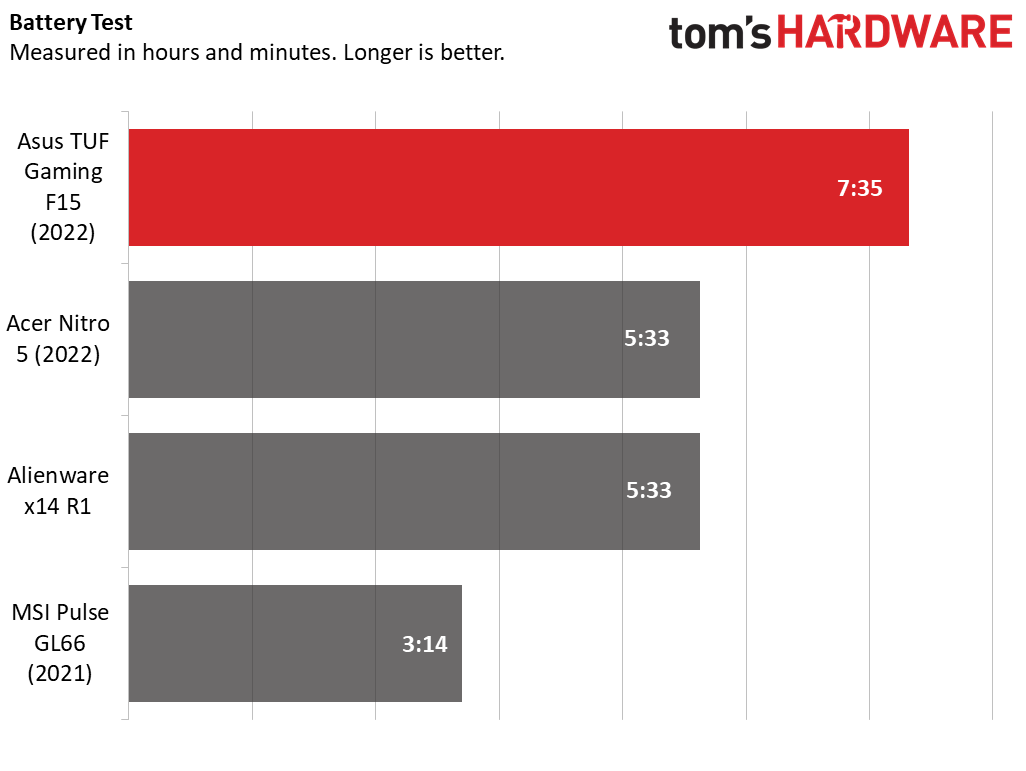Tom's Hardware Verdict
The Asus TUF Gaming F15 is a powerful budget laptop for gaming that can handle the latest titles in 1080p without a hiccup. But its webcam and speakers could use some work.
Pros
- +
Superb 1080p gaming
- +
Strong productivity capabilities
- +
Great price
Cons
- -
Poor webcam, touchpad, and speakers
- -
Some games appear washed out on display
Why you can trust Tom's Hardware
Who says mid-range laptops can't pack some power? Asus's TUF Gaming F15, equipped with a 12th gen Intel i7-12700H processor and one of the latest Nvidia GeForce RTX 3060 graphics cards, may be a mid-range machine, but we found that this $1,499.99 laptop is ready to play the latest titles without any hiccups at 1080p. However, just because it houses powerful components doesn’t mean everything else, like the webcam, touchpad, and speakers are up to snuff.
Still, the Asus TUF Gaming F15 is one of the better choices for strong 1080p gaming among the endless sea of mid-range options. On top of its gaming capabilities, it excels at productivity tasks, meaning the laptop is one of the best gaming laptops under $1,500.
Design of the Asus TUF Gaming F15
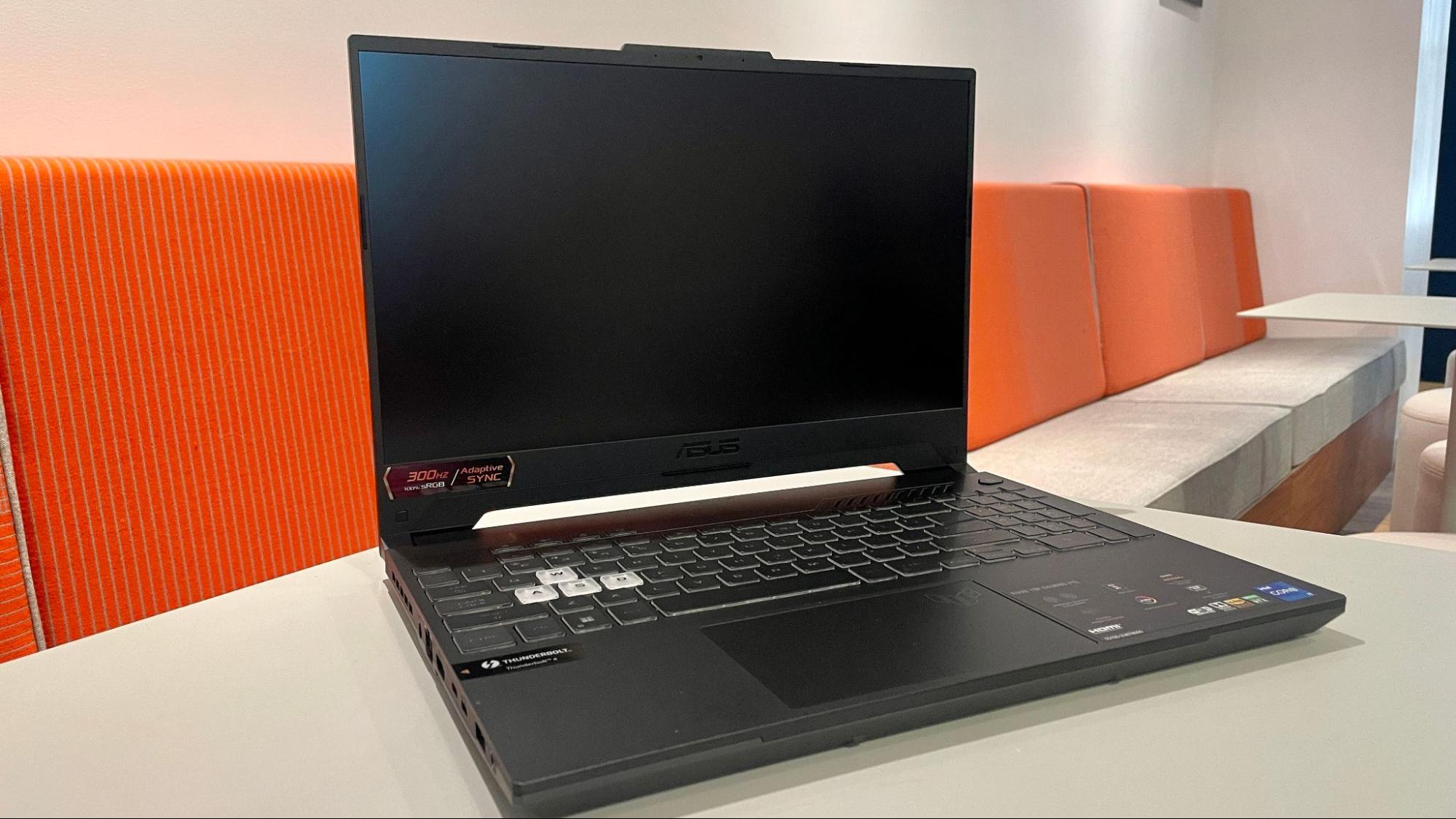

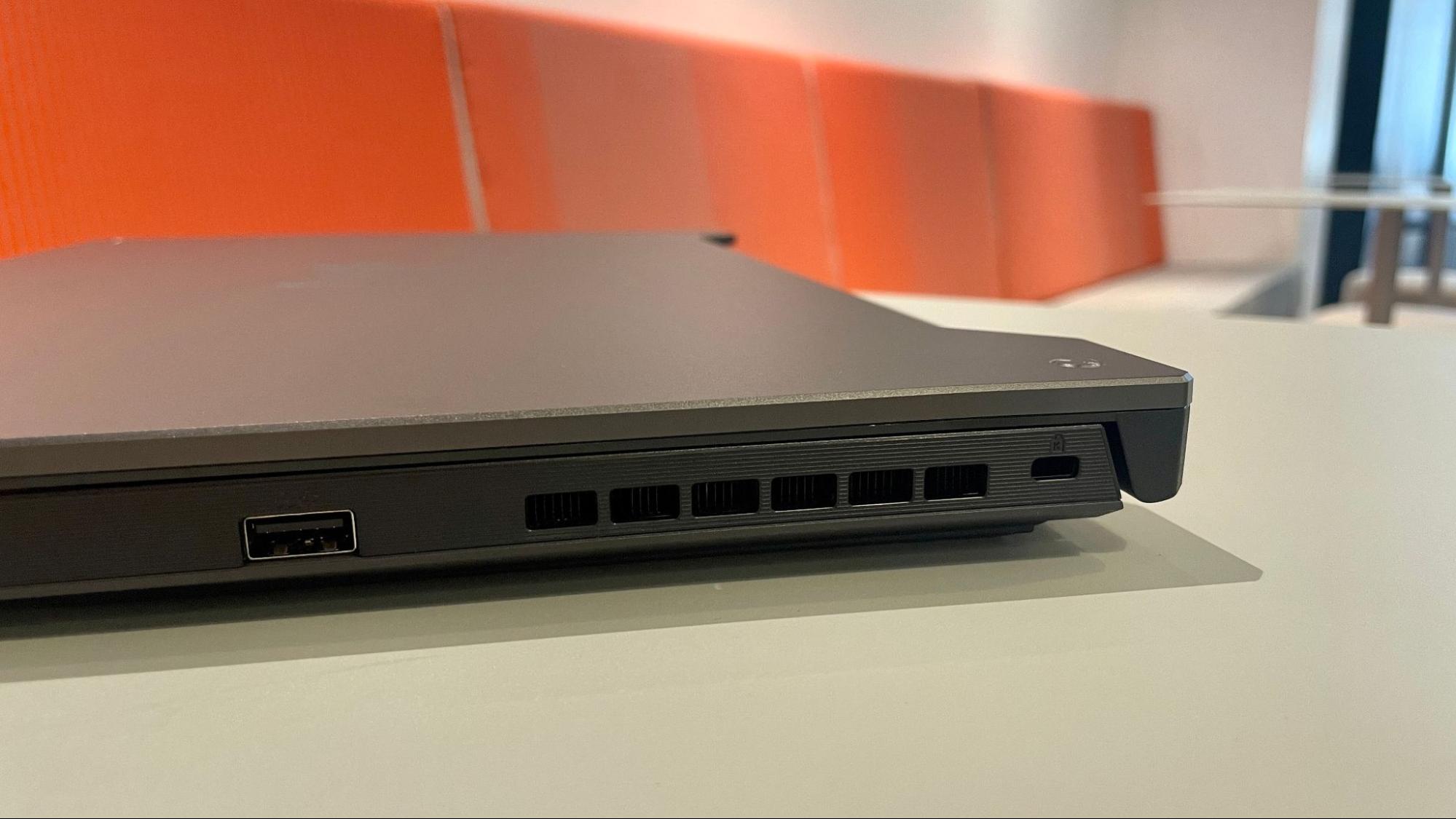


The Asus TUF Gaming F15 comes in a dark gray (or premiere white), meant to blend into any professional or casual environment, and it does. This iteration of the Gaming F15 sports minimized branding on the lid, which only includes a streamlined design of TUF shield at the center.
When you lift it open, there’s also a notch that houses the 720p webcam with which you can lift the lid. On the left side of the laptop, there is a port for the power adapter, an Ethernet port, an HDMI 2.0 port, a USB 3.2 Type-A port, a 3.5 mm jack, one USB 3.2 Type-C port and a Thunderbolt 4 port. On the right side is a single USB 3.2 Type-A port.
The Asus TUF Gaming F15 measures at 13.94 x 9.88 x 0.78 inches and weighs 4.41 pounds. Competitors like the Acer Nitro 5 come in at 14.19 x 10.67 x 1.06 inches and 5.51 pounds. Alternatively, the Alienware x14 R1 is slightly lighter at 12.66 x 10.35 x 0.57 inches and 4.06 pounds. Then there’s the MSI Pulse GL66, at 14.13 x 10.20 x 0.94 inches and 4.63 pounds.
Asus TUF Gaming F15 Specifications
| CPU | Intel Core i7-12700H |
| Graphics | NVIDIA GeForce RTX 3060 6GB GDDR6,1605 MHz Boost Clock, 140 W Max Graphics Power |
| Memory | 16GB DDR5 4800MHz |
| Storage | 1TB PCIe NVMe SSD |
| Display | 15.6-inch, 1920 x 1080, 300Hz, IPS |
| Networking | Wi-Fi 6 (802.11ax), Bluetooth 5.2 |
| Ports | Thunderbolt 4, USB 3.2 Gen 2 Type-C, 2x USB 3.2 Gen 1 Type-A, HDMI 2.0, Ethernet, 3.5mm headphone jack |
| Camera | 720p webcam |
| Battery | 90 Whr |
| Power Adapter | 240W |
| Operating System | Windows 11 Home |
| Dimensions (WxDxH) | 13.94 x 9.88 x 0.78 inches (354 x 250 x 19.81 mm) |
| Weight | 4.41 pounds (2 kg) |
| Price (as configured) | $1,499.99 |
Gaming and Graphics on the Asus TUF Gaming F15
We reviewed the Asus TUF Gaming F15 (2022) with an Intel Core i7-12700H and an Nvidia GeForce RTX 3060 GPU. The GPU has 6 GB of GDDR6 and a max graphics power of 140W, which explains how the Gaming F15 blows its competition out of the water when it comes to strong 1080p gaming. Competitors like Acer Nitro 5 (2022) and the Alienware x14 with RTX 3050 (4GB, DDR6) and 3060 (8GB, DDR5) cards, respectively.
When I played Hitman 3 (ultra settings, 1080p), everything ran smoothly and at a consistent 54 frames per second. As Agent 47, I efficiently assassinated foes and moved around the farmland of Colorado without any stutter. When I played Control (high settings, 1080p), I turned RTX settings to high and used DLSS to downscale the resolution to 720p. This maintained fluid gameplay at a consistent 56 fps while utilizing 99% of the GPU. Without DLSS, Control drops down to a jittery 30 fps.
Get Tom's Hardware's best news and in-depth reviews, straight to your inbox.
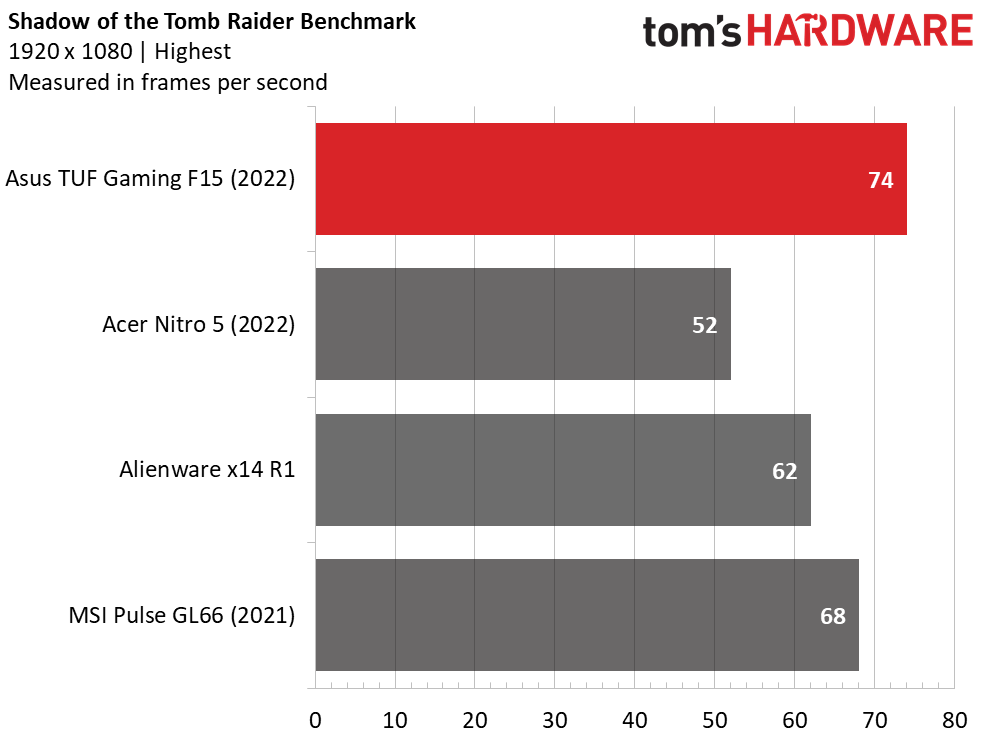




On the Shadow of the Tomb Raider benchmark (1080p, highest settings), the Gaming F15 churned out 74 fps. Meanwhile, the MSI Pulse GL66 (with an RTX 3060) achieved 68 fps, followed by the Alienware x14 R1 (RTX 3060), which got 62 fps, and the Acer Nitro 5’s (RTX 3050) 52 fps.
During benchmarks for Grand Theft Auto V (1080p, very high) the Gaming F15 hit an impressive 90 fps, followed by the Pulse’s 83 fps, Alienware’s 70 fps, and Acer Nitro 5’s 61 fps.
On the Far Cry 6 (1080p, ultra) benchmark, the Gaming F15 reached 97 fps, this time followed by Alienware with 94 fps, the Pulse with 83 fps, and the Acer Nitro at 70 fps.
On the benchmark for Borderlands 3 (1080p, "badass" settings), the Gaming F15 outperformed once again with 65 fps. The Alienware and the Pulse were neck and neck with 54 and 52 fps, respectively.
Finally, during the Red Dead Redemption 2 benchmark (1080p, medium), the Gaming F15 cleaned house with the most frames at 59 fps. The Pulse followed at 51 fps with the Alienware at 48 fps.
On gaming laptops, we stress test by running the Metro Exodus benchmark on RTX settings 15 times, simulating about half an hour of gameplay. The title ran at an average of 67.85 frames per second with some fluctuations throughout.
During the stress test, CPU speeds came in at an average of 3.71 GHz on the performance cores and 2.77 GHz on the efficiency cores. The temperature of the chip averaged 78.7 degrees Celsius (173.66 Fahrenheit), the same as the GPU. The GPU ran at an average of 1,425.59 MHz.
Productivity Performance on the Asus TUF Gaming F15
We tested the Asus TUF Gaming F15 with an Intel Core i7-12500H with 16GB of DDR5 RAM and 1TB of SSD storage. Although the laptop had little to no competition on the gaming front, competing laptops gave the Gaming F15 more of a challenge during productivity tests.



On Geekbench 5.4, the Gaming F15 earned an impressive single-core score of 1,781 and multi-core score of 12,705. The Alienware x14 R1 (i7-12700H) followed up with a single-core of 1,471 and multi-core of 13,353. In the rear were the Acer Nitro 5 (i5-12500H) with a 1,452 single and 9,148 multi-core score and the MSI Pulse GL66 (i7-11800H) with a 1,579 and 6,949 core scores.
During our Handbrake test, the Gaming F15 was the fastest to transcode a 4K video to 1080p, at 4 minutes and 49 seconds. The Alienware was slightly behind at 5:04, followed by the Acer Nitro 5 at 5:58 and MSI Pulse GL66 at 8:30.
The Asus TUF Gaming F15 copied 25GB of test files at an average of 607.64MBps, the slowest of the bunch, the Acer was the fastest at 1,240.65 MBps, with the Alienware right behind at 1,156.07MBps. The Pulse GL66 is the slowest at 801.1MBps.
Display on the Asus TUF Gaming F15
The Asus TUF Gaming F15 sports a 15-inch FHD 1920 x 1080p display with a 16:9 aspect ratio and a 300 Hz refresh rate. Those specs sound solid for gaming, but you'll need to pay more money if you want the best-looking display. Still, this one does a decent job, especially among its competitors.
I fired up the Disney Plus app to watch the penultimate episode of Moon Knight and was impressed by the sharp image and its color accuracy. Despite initially seeing the episode in 4K on my TV, the show still looked fantastic via the laptop. The sterile white halls that our protagonists find themselves in are bright and vibrant, no doubt thanks to the display’s 324 nits of brightness. The only competing laptop with a brighter screen is the Alienware x14 R1 with 377 nits.
However, games like Control looked washed out and bland in lighter areas. Colors didn’t pop as much as I thought they should in lighter locations where rays of light bounce off every wall, although they captured the darker corridors of the office space well enough. I feel like HDR could have solved these lack of vibrancy issues, but it may have added significantly to the cost of the laptop.
The Gaming F15's panel covered 79.5% of the DCI-P3 color gamut and 112% of the sRGB gamut. Meanwhile, the Alienware showed off 110% of the DCI-P3 color gamut and 77.7% of the sRGB gamut. The Acer Nitro 5 and MSI Pulse GL66 offered lower results here overall.
Keyboard and Touchpad on the Asus TUF Gaming F15
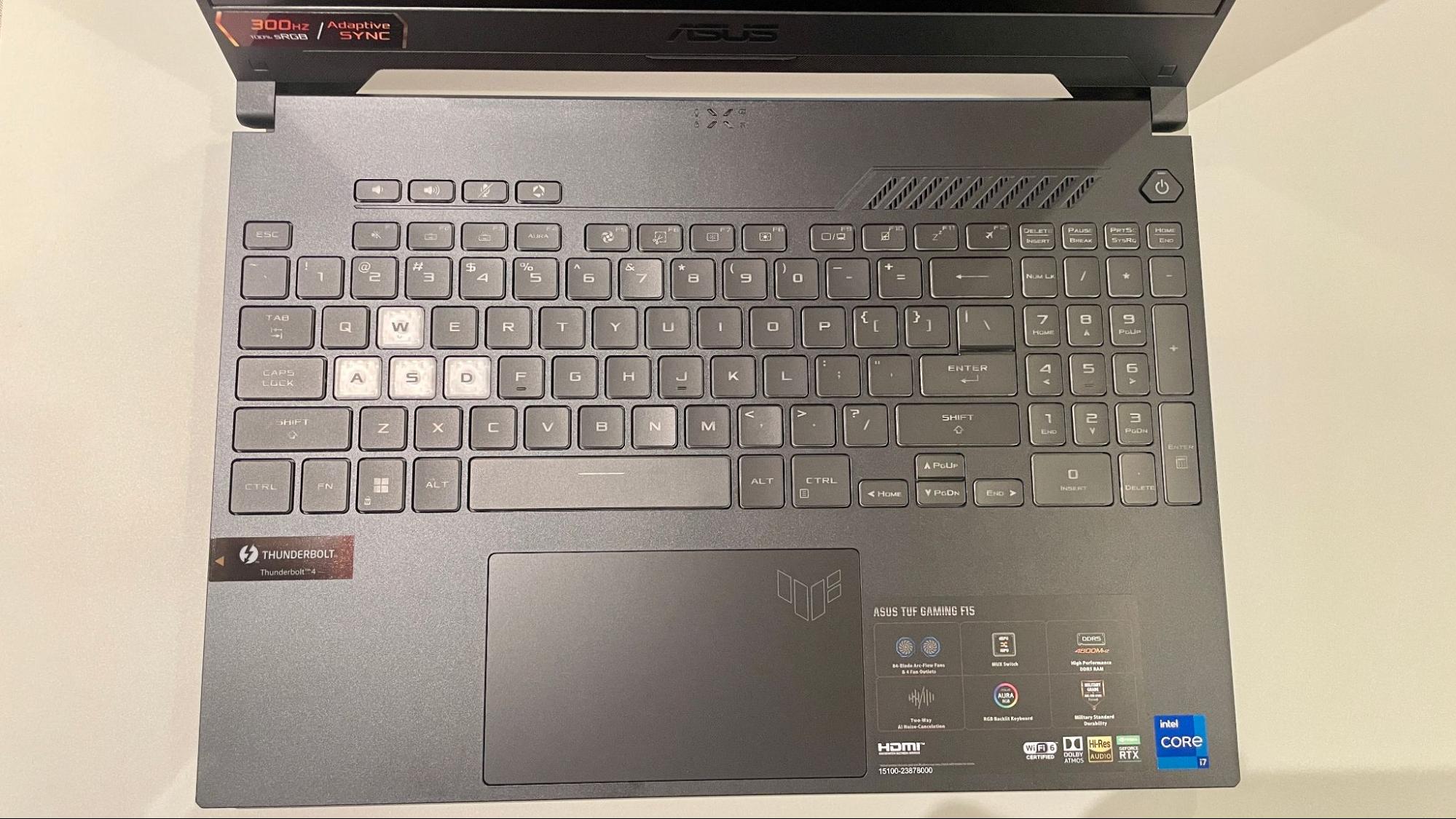

The Asus TUF Gaming F15 has a full keyboard complete with a number pad. Along the top of the keyboard are dedicated keys for the volume, mute the microphone, and open Asus’ Armoury Crate app. Using the Fn key in conjunction with the function keys allows you to cycle through the keyboard’s three lighting effects, change between “performance” and “silent” operation modes and more.
I enjoyed typing on the Gaming F15’s keyboard, the keycaps felt pleasant to touch and the switches were responsive. I also enjoy the added flair of the RGB lighting behind the keys. There are even clear caps for the WASD keys, which is a thoughtful nod to PC players.
My usual score on the 10fastfingers.com typing test is 60 words per minute with a desktop keyboard, and my score only dropped to 51 words per minute on this keyboard with roughly the same accuracy.
On the other hand, I did not enjoy the trackpad. It takes more effort than it should to click. I also thought the dimensions of the trackpad (4 x 2 inches) itself to be a bit small and could have benefited from being bigger.
Audio on the Asus TUF Gaming F15
Although the Asus TUF Gaming F15 has a hi-res certification and Dolby Atmos capabilities, its dual speaker audio speaker is usable, but I'd like something stronger. There’s only a single speaker above the keyboard and another hidden in the bottom bezel of the display. You can hear well enough when it's nearby, even subtle things like someone's footsteps were audible enough as I was watching Moon Knight. But I’ve heard superior audio quality from other Atmos-enabled laptops, such as the Lenovo IdeaPad Slim 7 Carbon.
The speakers handled music better than I thought, but it was still lacking. I listened to “Keisha From Belly” by Panama Plus and it had decent clarity. However, the speakers were barely able to make kicks from the track audible.
Upgradeability on the Asus TUF Gaming F15
The Asus TUF Gaming F15’s bottom plate is held by 12 Torx screws. They came off easily enough, and I didn’t need to apply much pressure with my prying tool to get the plate off. I immediately noticed a black protective film covering the laptop’s two slotted DDR5 RAM sticks and its occupied SSD slot. Underneath the black film was silver film covering the SSD slot, and below the SSD was the 90 Whr battery. Battery Life on the TUF Gaming F15.
The Asus TUF Gaming F15 lasted for seven hours and thirty-five minutes on our battery test, which continuously browses the web, streams video, and runs OpenGL tests while connected to Wi-Fi with the screen set to 150 nits of brightness. The Acer Nitro 5 and Alienware x14 R1 tied at 5:33. The MSI Pulse GL66 barely lasted over 3 hours.
Heat on the TUF Gaming F15



I tested the Asus TUF Gaming F15 to see how hot to the touch it gets while running the Metro Exodus stress test. At the center of the keyboard, the laptop reached 49.5 Celsius (121.01 degrees Fahrenheit) and wasn’t too hot to touch or type comfortably. Although it was noticeable when the fan came on, it wasn’t extremely loud. The touchpad remained cooler at 28.8 Celsius (83.84 Fahrenheit) and the bottom, which is usually the hottest spot, measured the temperature as the keyboard.
Webcam on the Asus TUF Gaming F15
Despite the TUF's display's great color accuracy, the Asus TUF Gaming F15’s 720p webcam is quite the opposite. The bronze tone of my skin alongside the reds in my Gaming F15 chair was completely washed out. The wall and my air purifier in the background were grainy and it was hard to see any details from the latter, such as the branding on the front and the small holes in the grate. Use this in a pinch, but most people should consider one of the best webcams instead.
Software and Warranty on the Asus TUF Gaming F15
There are two preinstalled apps from Asus: Armoury Crate and MyAsus. Armoury Crate displays real-time stats of your CPU/GPU, how much memory and storage is being used, the fan speed, and the temperature of your device.
Meanwhile, MyAsus is a hub that allows users to run diagnostics, customize the keyboard backlight, choose power & performance settings, access AI-noise cancellation features, and more.
Other than that, there’s minimal Windows 11 bloatware installed, including Disney Plus and Spotify.
Asus sells the TUF Gaming F15 with a one-year warranty.
Asus TUF Gaming F15 Configurations
We reviewed the sole, $1,499.99 configuration of the Asus TUF Gaming F15 (FX507ZM-ES74) with an Intel Core i7-12700H processor, Nvidia GeForce RTX 3060, 16GB of RAM and 1TB of storage. It also features a 15-inch, 1920 x 1080 display with a 300 Hz refresh rate.
Bottom Line
The Asus TUF Gaming F15 is a powerful 1080p gaming laptop with solid productivity performance. However, don’t expect your games to look as beautiful as they should. You’ll be able to game without a hiccup. While our colorimeter showed the display beating competitors, I still wished for something a bit nicer at this price.
While the webcam, touchpad, and speakers may be secondary concerns for some PC gamers, those who will use this as a productivity notebook may want to consider options other than the F15 because of it. The Gigabyte Aero 16 excels at productivity and can do some great 1080p gaming. It even has an OLED display for only a few extra hundred bucks than the Gaming F15. But for $1,499, the Asus TUF Gaming F15 is a strong mid-range choice to enter the RTX 30 series club with.

Isaac Rouse is a staff writer at Tom's Hardware. He reviews laptops and various gaming peripherals.


